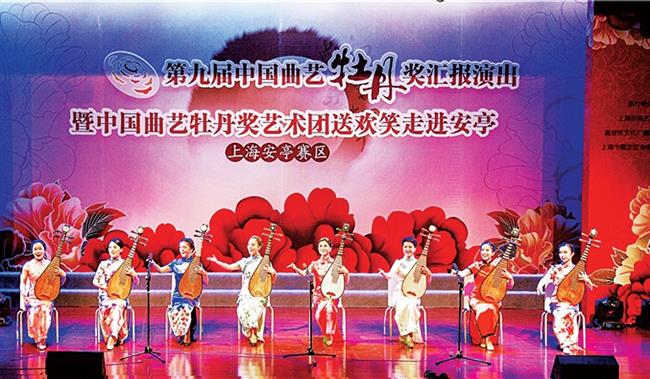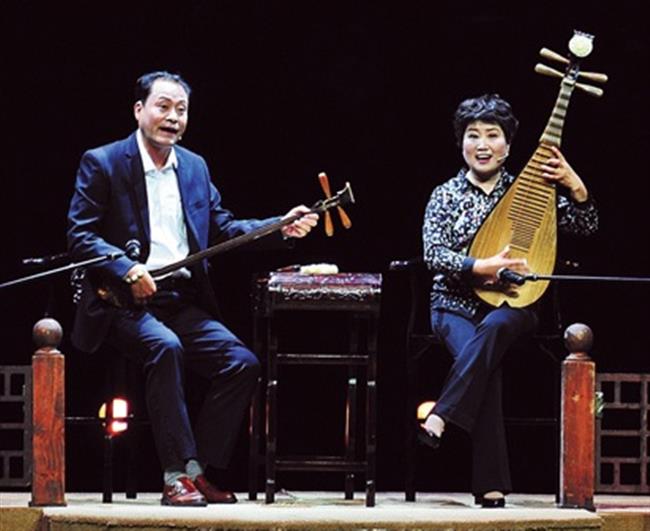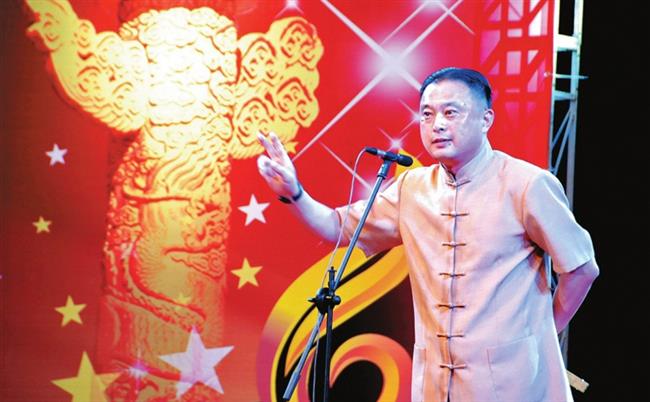Quyi artists fill theaters again with their stories

Pingtan artists tell stories by singing in the Suzhou dialect while plucking the traditional Chinese instrument pipa during a show in Anting Town.
Quyi is the general term for several hundred speaking and singing art forms. Quyi is profoundly rooted in Chinese history and culture. In ancient times, both storytelling and comic performances were widespread and popular with both nobility and ordinary people.
Jiading never lacked quyi artists, or folk storytelling artists passing down an oral record of the past from generation to generation.
Century-old cultures and traditions are verbally transmitted in speech or song and may take the form of folktales, sayings, ballads or chants. Learning what they did and thought allows us to feel the warmth of Jiading.
A town of quyi artists
Jiading has been known as a “town of quyi,” the strong atmosphere of quyi here can’t exist without a group of artists behind or in front of the stage.
Quyi artists started rising in Jiading in the Qing Dynasty (1644-1911). One of the most popular genres of quyi is pingtan, a story-telling art in Suzhou dialect. Pingtan artist Zhao Zhengqing was among the first to gain a widespread reputation as he gave touring performances in theaters throughout Jiading.
Zhao was a disciple of Ma Rufei, who founded madiao, a popular singing style of pingtan in the Qing Dynasty. Zhao then presented “Pearl Pagoda” to audiences and became a household name.
In modern times, Zhang Mengfei, Chen Shuzhong, Zhu Yeqi, Zhu Demo, Fei Xiangbao, Guan Hukui, Shen Lingli, Huang Jiaming, Song Jianxing and Huang Zhenliang are the best pingtan artists of Jiading.
Fei Xiangbao, born in the 1950s, was not only a pingtan storyteller but also a writer and composer. Fei created a number of oral works involving storytelling, singing, talk shows and monologues during his tenure as head of Jiading Cultural Center and Nanxiang Cultural Center.
“Previously we didn’t have too many entertainment activities but went to theaters for opera and storytelling performances,” Fei said.
Fei completed his first work in 1972 when he taught at Jiading No. 1 High School. His second piece, “Good Sister-in-Law,” won an award as best amateur work.
In the 1980s, Fei and his colleagues regularly presented performances out in the community. When they arrived at a neighborhood or a village, they built a stage and began performing.
No box office, no ticket revenue, but a large audience who sat under the stage all day long.
Later Fei went to Shanghai Normal University to study at the department of Chinese language and literature. After that, he created new works almost every year.
Unlike Fei, Zhu Demo wrote stories only. Zhu produced more than a dozen stories every year and won many awards at home and abroad. It usually took him a fortnight to write a story.
 Ran Tao / Ti Gong
Ran Tao / Ti GongArtists from Jiading perform pingtan during a quyi competition in Shanghai in 2017.
Time slows down in story theaters
Once there were story theaters everywhere in Jiading where storytellers presented tales of kings or knights as well as romances.
Early last century, the district had more than 40 story theaters. In 1987, the district’s story theaters staged 3,651 performances, attracting more than 400,000 people.
However, most of the story theaters closed with the rise of video lounges and ballrooms. Wu Jinglai, a Nanxiang native, has been a fan of pingtan for nearly 60 years. “Pingtan was the most popular entertainment activity in the 1950s. Story theaters were everywhere, and there were often rival shows,” Wu said.
Performers at that time took up to 40 percent of the box office, and hence polished their skills constantly to attract bigger audiences.
Some time-honored story theaters have reopened in recent years, and tickets are hard to get. Viewers arrive at noon, sitting on wooden chairs with a hot cup of tea.
Pingtan is a slow art. It can take performers half a month to tell a story with a small fragment every day. Most viewers are elderly people and story theaters are another home for them, said Wu.
 Ran Tao / Ti Gong
Ran Tao / Ti GongHuang Zhenliang, a renowned shuoshu artist, tells stories on stage, wearing his iconic cheongsam with his hair well-combed.
Huang is the best
Chen Hai, a cabbie in his 50s, said his favorite radio program was Huang Zhenliang’s “Let’s talk stories.”
Huang, a native of Jiading’s Huangdu Town, listened to his grandfather telling stories when he was a child. When he grew up he became famous for his shuoshu art, another genre of quyi.
Always wearing a cheongsam on stage and with his hair well-combed, Huang successfully built an image for himself.
A storyteller speaking the Suzhou dialect, Huang performed on stage and on radio. “Let’s talk stories” on Shanghai People’s Radio Station has become increasingly popular.
He also fixed details of stories and performance in line with audience’s suggestions to make them more realistic. His portrayal of historic figures in contemporary Shanghai was highly praised by senior citizens who were familiar with them.
A Jiading girl Lu Hua became his first disciple. When Lu entered a storytelling competition at the age of 14, Huang, who judged the competition, highlighted a number of points in Lu’s performance.
After the contest, Huang asked her: “Are you willing to be my disciple?” Lu immediately called him the master and began to learn the art of storytelling.
The inheritance of storytelling is making progress. Huang and other quyi masters go to schools to teach students the traditional art forms. Lu puts her storytelling performances online, including on China’s largest audio platform Ximalaya FM.
There are storytelling contests and all sorts of quyi training courses in Jiading every year. At present, hundreds of professional and amateur performers carry the torch and continue the legend.
